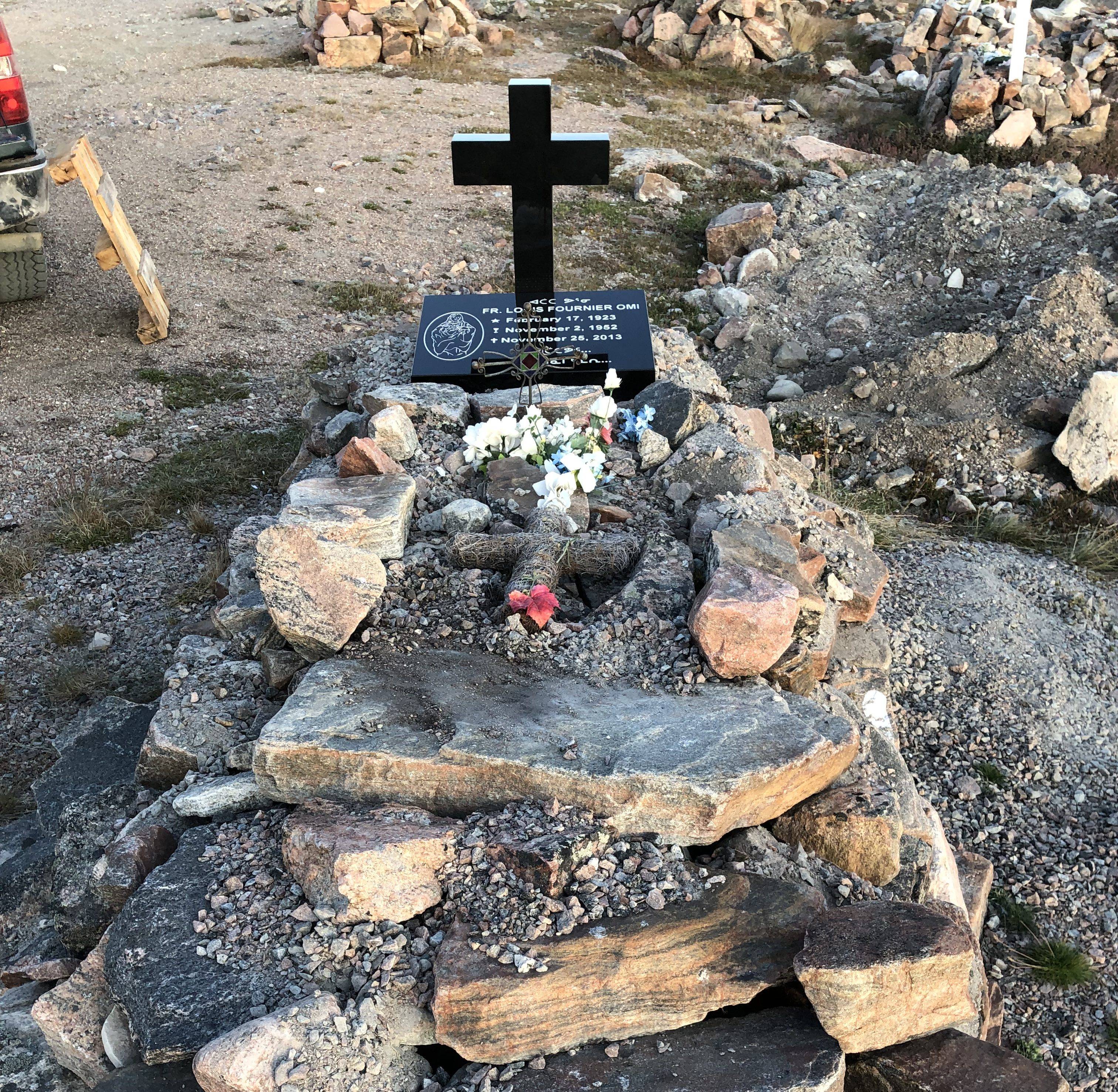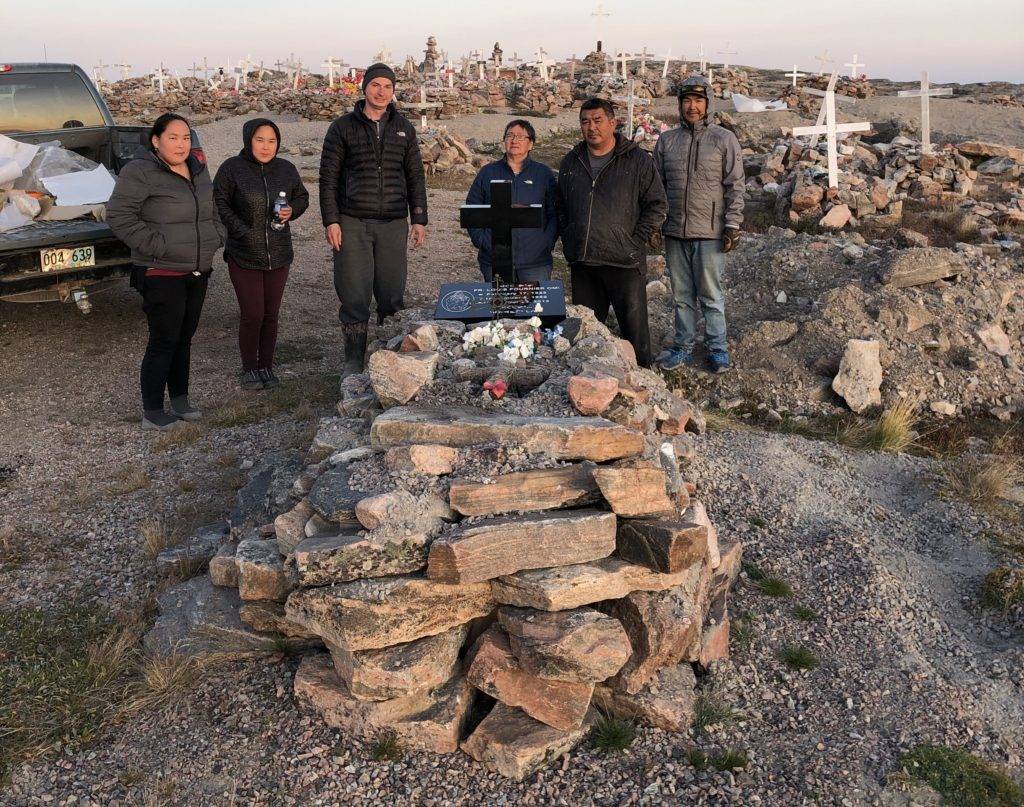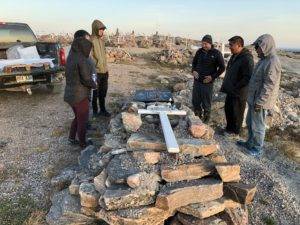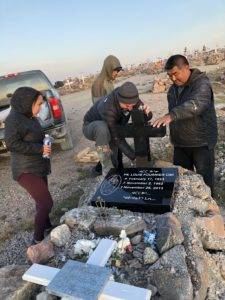Fr. Louis Fournier, OMI
RIP
Last Wednesday the first ship arrived to Naujaat and it brought the tomb stone for Fr. Louis Fournier, OMI. Last night, with some parishioners, we installed it on his grave. In Naujaat, the ground is solid rock so we don’t dig graves here. We put the coffin (plywood box) on the ground and cover it with rocks. Father Fournier OMI served Inuit people in the far North of Canada for 60 years, from 1953 till he died in 2013. He died in his mission in Coral Harbour but is buried in Naujaat where he spend 20 years (1987-2007) His motto was “God first” and he was always faithful to it, putting God first in his life, and in his ministry. His main concern was to bring people to know and love God. May he rest in peace.
The article below was written by Daniel Szwarc, OMI after Fr. Louis’ passing in 2013:
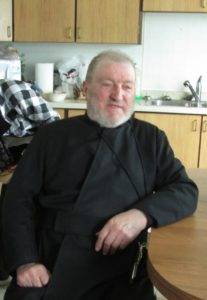 “Our principal service in the Church is to proclaim Christ and His Kingdom to the most abandoned” (const. 5).
“Our principal service in the Church is to proclaim Christ and His Kingdom to the most abandoned” (const. 5).
Father Louis Fournier OMI remained faithful to this charism, the charism of the Missionary Oblates of Mary Immaculate, till the last day of his life. Born in France in 1923, he entered the diocesan seminary but, discovering his missionary vocation, he joined the missionary oblates and after being ordained in 1952 he came to the Canadian Arctic. It was 1953; he was 30 years old at that time. He was sent to the mission in Iglulik. The Arctic was very different then than what it is today. People were still living in small camps out on the land. There were no towns at all. In the small mission of Iglulik, Fr. Trebaol OMI was the superior. He didn’t like to travel so it was Fr. Fournier’s job to visit all the families spread in the vast land of Iglulik. He had to learn Inuktitut, which at that time was the only language spoken by Inuit. He had to learn the culture, customs, mentality and way of living in this frozen parts of the world. Once he went to visit families living at Iglulik Point. He went as usual by his dog team. It was spring time so the snow was becoming wet and soft. On the sea shore during high tide, the water started to come up and overflow the ice. After finishing his ministry he started heading back. Then his sled got stuck in the soft snow right at the sea shore. He had to get off the sled and into the snow mixed with the sea water and try to move his sled. It was very hard. Then he noticed a group of Inuit standing on the small hill nearby and watching him. Not one came to help him. He was very mad, he recalled. After a long time of struggling he got his sled free and came back to the mission. He told the whole story to Fr. Trebaol who explained to him that the Inuit didn’t help him because they knew that he didn’t need the help. They believed that he would manage by himself, so it was a sign of the respect. Learning the Inuit culture and mentality was not easy as it is not easy today and Fr Fournier who passed through that school of life in the Far North was always ready to help us, the young oblates who still are passing this test.
Life in the North started to change very rapidly with the developing of the Cold War. The towns started to grow where before there was just a mission and a Hudson Bay trading post. The life style changed from semi-nomadic to a settled one. People started to live in the communities; the daily food was now more often brought from the store and not from the land. Hudson Bay Company held the monopoly in business. The idea arose to start a business owned by Inuit, a business which would serve people. Fr. Fournier became one of the founding fathers of Co-op stores in the Far North.
But with better connections with the South not only good things were coming to the North. A new plague started among Inuit. That time it wasn’t starvation or tuberculosis. This time it was alcoholism. At this point there are a few different opinions about Father Fournier. Some people say that it was too much for him and he wanted to run away, to retire from public life. Other people say that he wanted to start a new community, where Christian families would live a life according to God’s commandments. Those opinions are based on the fact that in 1973 Fr Fournier decided to leave Iglulik and build a new town. He chose the shores of Baffin Island, east from Iglulik, a place was called Ikpik. By chartered plane he had building materials brought to the site and he built there a church and four round-shaped houses. He recalled wolves welcoming them at the site when they were unloading the plane. They were just standing up on the hill and watching them. For safety they always had to have a gun ready at the hand. Fr Fournier and a couple of families started this new community. One day a boy came to visit Fr Fournier in his house. Father was busy with something so the boy just played around. Suddenly there was a gun shot. Thanks be to God nobody got hurt but Fr Fournier was upset enough to scold the boy. Several weeks later he found a bullet in one of his books.
The idea of Ikpik didn’t work out. The families kept going back to Iglulik and after five years the project was abandoned. But why did it start at all? What was Fr Fournier’s real intention in moving there? Knowing Fr Fournier i am sure that it was his response to the new problems of Inuit people. He knew that there was no way to stop alcohol from coming up North. He knew that he could not do anything to stop the life style from changing, but he also knew that he could not just sit and do nothing about it. He wanted to move to Ikpik alone and dedicate his life to prayer, to prayer for Inuit people. That was his answer to the problems that started to become overwhelming. Bishop Robidoux OMI didn’t agree to this idea. He gave Fr Fournier permission to move to Ikpik under a condition that he will take with him some of the Iglulik families. In 1978 Fr Fournier had a heart problem and had to go to the hospital in Frobisher Bay as he always called Iqaluit. They gave him several treatments there. The first surgery they performed on him, as he was recalled with a big smile, was to take off his clothes and to wash him. Bishop Robidoux OMI said that his heart condition was a sign that he should not go back to Ikpik. Fr Fournier accepted in the spirit of obedience.
Following that he served in Iqaluit, Whale Cove and Repulse Bay. He moved to Repulse Bay in 1987 and stayed there for the next 20 years. In 2007 the time came for him to retire. It was not an easy decision for him but he was feeling very tired and the growing community of Repulse Bay was too much for him. Finally in October that year Fr Fournier moved to Winnipeg. After 54 years of service and life in very isolated hamlets he moved to a city. Of course it doesn’t surprise anybody that a man with his heart, a heart just like the one of St Eugene, big enough to love the whole world, and after so many years of life in solitude, he didn’t like the life in a retirement house. “I don’t like it here- he said once- almost every day somebody dies”. After a of couple of months in Winnipeg he went to his native France still debating whether he should retire in Canada or in his Homeland. He spent several weeks with his family and then he made the decision to come back North. And so he did. For the six last years of his life he served Inuit people in Coral Harbour, helping also from time to time missions in Repulse Bay, Whale Cove and Arviat. On November 25, 2013, around 8PM a son of local church leaders was passing by the mission in Coral Harbour. He noticed that the door to the mission was open so he stopped and came in. Fr Fournier was lying down; close to his body was his prayer book. Nobody saw how it happened, nobody witnessed his last moments but considering the time I would guess that he was coming back from the church after the Mass which he always celebrated at 7 PM. The longest serving Oblate to the Inuit people went to his Father’s House.
Why did he come back from his retirement? Why didn’t he choose to stay in a city in the South of Canada or in France? St Eugene in the preface to the Constitutions and Rules wrote: Oblates must be “ready to sacrifice goods, talents, ease, self, even their life, for the love of Jesus Christ, the service of the Church and the sanctification of brothers”. This and the dedication to “the most abandoned” had shaped Fr Fournier’s oblate life. In 1938 pope Pius XI called Missionary Oblates of Mary Immaculate the specialists in the most difficult missions. The Holy Father said this after a visit form Fr Prime Girard OMI a founder of the most northern mission of Pond Inlet. Fr Fournier was without any doubt the best specialist of the Arctic missions, the most difficult missions. Although life conditions in the Arctic have changed since then and we could discuss which missions are the most difficult today, there is no doubt that the missions among Inuit are the missions among the most abandoned. And it is, I think, the most important reason why Fr Fournier came back and why he never quit, even if many times he heard that he deserved retirement, that he deserved a rest. “I am like a farmer- he said- and a farmer never gets a vacation, and never retires”. I am sure that if there had been enough oblates that would be willing to work in those missions, he would have retired. The Inuit are, without any doubt, the most abandoned and there are very few oblates who answer the call to live with them and proclaim to them the Good News of salvation.
At the meeting between Pope Pius XI and Fr Girard OMI, the Holy Father also said “even if there was just one family living there and even if it would take two years to reach them, go because they too deserve to be saved”. Fr Fournier was fulfilling this order of the Holy Father his whole life. Many of his projects failed, he saw people moving away from faith, from prayer, from the Church but he never gave up, he never got discouraged and our hope is that from where he is now he will still help Inuit and those Oblates who have the courage to answer the call to work among the most abandoned and who have the courage to be faithful to the charism of St. Eugene de Mazenod.
By Daniel Szwarc, OMI


